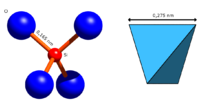Island silicates
As island silicates (nesosilicates) is referred to silicates , the silicate anions from isolated SiO 4 - tetrahedrons exist, d. H. the SiO 4 tetrahedra are not connected to one another via Si-O-Si bonds.
This department of silicates includes the important rock-forming minerals of the garnet and olive group , zircon and the economically or petrologically important aluminosilicates andalusite , sillimanite , thistle , staurolite and topaz .
The simple structure of the SiO 4 complex anion does not result in any pronounced directional dependence of the properties of the island silicates. They are often cubic, tetragonal, trigonal, hexagonal or orthorhombic and usually form isometric crystals. The minerals in this division are mostly hard and have a high refractive index and a relatively high density .
classification
In Liebau's mineral classification, the island silicates, like the group silicates and ring silicates, belong to the silicates with dimensionality 0. The extent of the silicate anions is not unlimited in any direction (0 dimensions).
Strunz's classification arranges the island silicates division (9.A) according to the chemical environment of the cations in the structure and according to the occurrence and type of other anions.
9.AA island silicates without further anions; Cations in tetrahedral [4] coordination
9.AB island silicates without further anions; Cations in tetrahedral [4] and greater coordination
9.AC island silicates without further anions; Cations in octahedral [6] coordination
- 9.AC.05 Olivine group
- 9.AC.10 Monticellite group
- 9.AC.15 Ringwoodite group
9.AD island silicates without further anions; Cations in octahedral [6] and usually greater coordination
- 9.AD.05 Larnite group
- 9.AD.10 Calcio-olivine group
- 9.AD.15 Merwinit Group
- 9.AD.20 Bredigit group
- 9.AD.25 Garnet Group
- 9.AD.30 Zircon Group
- 9.AD.35 Huttonite Group
- 9.AD.40 Eulytin group
- 9.AD.45 Reidit group
9.AE island silicates with additional (O, OH, F, H2O); Cations in tetrahedral [4] and usually greater coordination
- 9.AE.05 beryllite group
- 9.AE.10 Euclas group
- 9.AE.15 Sverigeit group
- 9.AE.20 Hodgkinsonite group
- 9.AE.25 Gerstmannite group
- 9.AE.30 Klinoedrit group
- 9.AE.35 Stringhamite Group
- 9.AE.40 catoptrite group
- 9.AE.45 Yeatmanit group
- 9.AE.50 Sphaerobertrandit group
9.AF island silicates with additional anions; Cations in [4], [5] and / or only [6] coordination
- 9.AF.05 Sillimanit Group
- 9.AF.10 andalusite group
- 9.AF.15 Kyanite group
- 9.AF.20 mullite group
- 9.AF.23 Boromullite
- 9.AF.25 Yoderit group
- 9.AF.30 staurolite group
- 9.AF.35 Topaz Group
- 9.AF.40 Norbergite group
- 9.AF.45 Chondrodite group
- 9.AF.50 Humit group
- 9.AF.55 clinohumite group
- 9.AF.60 Leukophoenicit group
- 9.AF.65 Ribbeit group
- 9.AF.70 Jerrygibbsite group
- 9.AF.75 Welinit Group
- 9.AF.80 ellenbergerite group
- 9.AF.85 chloritoid group
- 9.AF.90 Poldervaartite group
9.AG island silicates with additional anions; Cations in mostly [6] and> [6] coordination
- AGG 9, 2005 Braunit group
- 9.AG.15 Titanit group
- 9.AG.30 Sitinakit group
- 9.AG.35 Kittatinnyit group
- 9.AG.40 natisite group
- 9.AG.55 Chantalite group
- 9.AG.60 Vuagnatite Group
- 9.AG.65 Hatrurit Group
- 9.AG.70 Jasmundite group
- 9.AG.85 Zoltaiite group
9.AH island silicates with CO3, SO4, PO4, etc.
- 9.AH.20 Ternesit group
- 9.AH.60 Nagelschmidtit Group
9.AJ Island silicates with BO3 triangles and / or B [4], Be [4] tetrahedra, corner-dividing with SiO4
- 9.AJ.05 Grandidierite group
- 9.AJ.10 dumortierite group
- 9.AJ.15 Garrelsite Group
- 9.AJ.20 Datolith group
- 9.AJ.35 Vicanitgruppe
9. AK Uranyl island and sheet silicates with U: Si = 2: 1
- 9.AK.05 Soddyit group
- 9.AK.10 Sklodovskite group
- 9.AK.15 Uranophane group
- 9.AK.20 Swamboit (Nd) group
- 9.AK.25 Haiweeit group
- 9.AK.30 Weeksit group
- 9.AK.35 Ursilit group
- 9.AK.40 uranosilite group
Individual evidence
- ↑ a b Liebau 1982
- ↑ a b University of Tübingen: Systematics of Minerals - Nesosilicates (island silicates)
- ↑ a b c d e f g h i j k l Mineral class 9.A according to Strunz 9th edition
- ↑ a b c d e f g h i j k l Nickel-Strunz Silicates Classification (Version 10)
- ↑ a b c d e f g h i j k l Nickel-Strunz Classification - Nesosilicates 10th edition
Web links
- webmineral: Nickel-Strunz Silicates Classification (Version 10)
- Mineralienatlas : Mineral class 9.A according to Strunz 9th edition - island silicates (nesosilicates)
- mindat.org: Nickel-Strunz Classification - Nesosilicates 10th edition
- University of Tübingen: Systematics of the minerals
- Comprehensive description of the different island silicates
literature
- F. Liebau (1982): Classification of Silicates in: Reviews in Mineralogy Volume 5: Orthosilicates; Mineralogical Society of America






